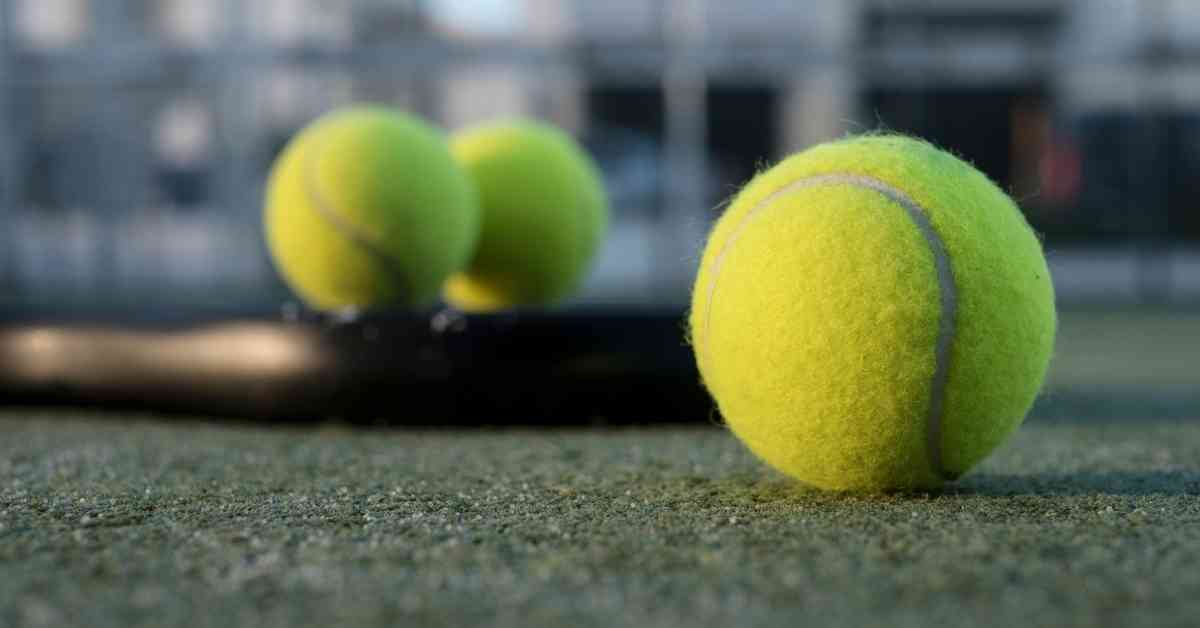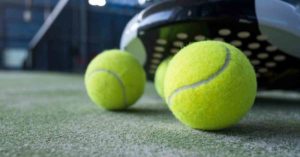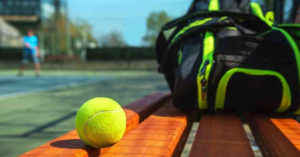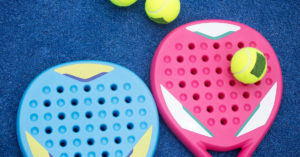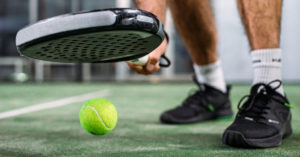When you discovered Padel for the first time, you probably notice that the sport is very similar to tennis. The scoring, the net, and the surface of the courts are quite similar.
So, it’s no surprise that many people get confused with these sports. However, we are here to help you.
Padel is a mix of tennis and squash. As opposed to tennis, padel is played on the court and has walls like squash. Just like the rackets, the courts, and walls, padel balls are also different from tennis balls. Visually, the balls are difficult to distinguish from each other. Both sports mainly use yellow balls with often the same brand and yet they are different.
One is a padel ball and the other a tennis ball. Even though they look very much alike, you may wonder if you can use tennis balls for padel?
No, Padel balls and tennis balls are different, and for a good reason. This is mainly due to fact that both balls have to respond to different needs within both separate sports.
But if we dig deeper and look at the different requirements you will find an answer that might surprise you.
You can not use new tennis balls for padel and you cannot use padel balls for tennis but why is that. In the article below we will explain the differences between the two below. We will also explain how you could use tennis balls for padel.
Table of Contents
Padel vs Tennis
The main difference between Padel and Tennis
Before we dive into what makes a padel ball different from a tennis ball, it’s important to have a better look at the main differences between the sports; the courts, the rackets, how this affects the game, and why it is important to play with a suitable ball.
Court
First of all, the court. It should be no surprise that a padel court is much different than a tennis court. At a first glance, a padel court looks much more like a squash court than anything related to tennis. Surrounded by glass walls and mesh fencing, they play a big role within the game.
Also, a padel court is around the court is 30% smaller than a tennis court and that’s just for the surface. As the high walls and fences block you from going outside these lines, a tennis court has more than double the playing surface.
A padel ball, therefore, has less distance to cover per game. It should therefore be less bouncy.
Racket
Secondly, what strikes most people is the original shape of a padel racket. Since it has no strings it looks more like a beach ball racket than anything related to tennis. Also, the racket has a strap at the end of the handle which the player must wear around their wrist while playing.
The surface of a padel racket is full of holes made with different layers and varieties of foam as opposed to a tennis racket which is longer and uses strings to play the ball.
Compared to a tennis racket, this means that you have to exert much more force to move a ball. In combination with the court, there is much less need to have a fast and bouncy ball.
Play
Besides the fact that padel is much easier to learn and Hence, it’s no wonder that the sport is growing at a fast rate worldwide.
An average rally in padel has four to six strokes per individual. Whereas in a tennis match, it can have an average rally of zero to four strokes.
Training vs matches
Oficial matches
In competitions, you are actually obliged to use the official padel balls. Balls quickly lose their properties over time. A new bus with balls is therefore used during any official match. This ensures that everyone is equal in the game. One should not have an advantage over the other because his or her used balls are played with.
Training
But what about training, are you also obliged to use new balls? No, with the training you are free to do it even though we recommend renewing the balls often enough because not all balls keep their properties for the same time.
How do you know if a ball is still good enough to play with and who determines this?
Padel ball Requirements
Padel and Tennis are two independent sports with two separate governing bodies and therefore rules.
Both sports have their own governing bodies:
- For Padel, that’s the IPF: International Padel Federation
- For tennis, it’s the ITF: International Tennis Federation
These bodies record all aspects of the sports, including the rules for the different balls.
In order to participate in an official match, used balls must be meet established values in terms of pressure, bounce height, dimensions, weight, color, and material
Below we will evaluate each aspect of each ball for both Padel and tennis sports to see if tennis balls can be used for playing padel.
Pressure
The biggest difference between the padel balls and tennis balls is the pressure:
- Padel balls: less pressure / softer: new between 10 psi and 11 psi
- Tennis Balls: more pressure / Harder: New 14psi
For both balls, there is no overlap in terms of amounts of pressure.
The pressure of a padel ball is lower than that of a tennis ball. The only way a ball could be used for both sports is if a tennis ball had less pressure
Also, the pressure in a ball has a direct influence on other factors on balls, be it for padel or tennis.
Bounce height
One of those factors is bounce height. Balls must meet a minimum and maximum bounce height. This means that if the ball falls from a set height, the ball bounces within that minimum and maximum height.
With both padel and tennis balls, this height is set at 254 cm high
- Padel balls: should bounce the ball to between 135 and 145 cm high
- Tennis balls: should bounce the ball to between 135 and 147 cm high
A tennis ball, therefore, has a higher maximum bounce height.
But a ball that bounces between 135 cm and 145 cm could be used for both
Weight
The weight of balls is also specified in the official rules.
- Padel balls: between 56 and 59.4 grams
- Tennis balls: between 56 and 59.4 grams
This is the same for both balls
If we only look at the weight, new balls would suffice for both sports
Size
The size of the two types of balls is also determined differently. Official balls must meet a size between the following two extremes
- Padel balls: between 6.35 and 6.77 cm.
- Tennis balls: between 6.54 and 6.86 cm.
A tennis ball could therefore be slightly larger. This is directly related to the higher pressure in the tennis ball. The higher the pressure, the bigger the ball.
However, it is striking that there is a lot of overlap. A ball between 6.54 cm and 6.77 cm could therefore be used for both sports. If we only look at the size.
Colors
The choice of available colors is quite small because there are only two of the same options for both sports
- Padel balls: white or yellow.
- Tennis balls: white or yellow.
Both sports use the same colors
Even though it is difficult to find white balls, we always recommend going for yellow balls. This is for good reason. You can see the yellow balls better against the white lines of the padel court, so you can see them better.
Material
Both balls are made of the same type of fabric
- Padel balls: felt
- Tennis balls: felt.
So there is no difference in the material; felt is the only choice
In addition, felt is used in the same amount, on each ball you will find the same amount of material. Balls, therefore, consist of the same amount of felt. And thus the weight is identical between the two balls.
Summary
In the table below you will find the summary of what we explained above in terms of pressure, bounce height, dimensions, weight, color and material for balls within both sports
| Padel | Tennis | Overlap | |
| Pressure | between 10 and 11 psi | 14 psi | none |
| Size | between 6,35 and 6,77 cm | between 6,54 and 6,86 cm | between 6,54 and 6,77 cm |
| Weight | between 56 and 59,4 grams | between 56 and 59,4 grams | between 56 and 59,4 grams |
| Bouncing height (with drop from 254 cm) | between 135 and 145 cm | between 135 and 147 cm | between 135 and 145 cm |
| Color | White or yellow | White or yellow | White or yellow |
| Material | Felt | Felt | Felt |
A ball must meet the above properties in order to be used in an official match.
If we look at the last column “overlap”, we can see that a ball could therefore be sufficient for both sports if it has the following properties:
- Dimensions: between 6.54 and 6.77 cm
- Weight: between 56 and 59.4 grams
- Bouncing height: between 135 and 145 cm
- Color: white or yellow
- Material: felt
The only thing that is missing is the pressure, there is no overlap on this property and this is problematic because new balls have to be used for every match.
Exceptions
There are some exceptions for padel at high altitudes. At altitudes above 500 m, a special “high altitude ball” must be used. This has to do with the pressure difference. The higher you are, the less pressure there is in the atmosphere. This also affects the pressure in the ball itself.
Fortunately, we don’t have much trouble with this in the Netherlands.
The weight and size of the “high altitude ball” are the same as a regular padel ball as we have explained above. So the only difference is the pressure in the ball
Which padel ball
To make sure that balls are good for official use, the World Padel Tour Championship has an official ball: the Padel Pro ball from the tennis brand and padel brand Head.
It comes in two variants
- Head Padel Pro: the Head padel Pro ball meets all requirements and is our recommendation if you want to buy padel balls. Then you’re always good.
- Head Padel Pro “S”: This variant is slightly smaller and slightly faster than the standard variant and is mainly used in the professional circuit. This makes the game more intensive and therefore more challenging for seasoned padel players.
Conclusion
Since tennis and padel are two completely different sports, different rules have been established. Including rules for the balls.
Even though the balls look similar, there is a difference in pressure, bounce height and size for balls within both sports.
Pressure plays the biggest factor here as it directly affects bounce height and size.
But this big difference ensures that you really can’t use new tennis balls for padel.
With a padel racket, it is impossible to hit this heavier ball during an entire match or training. This can cause injuries.
Playing padel with tennis balls is therefore absolutely not recommended. You will therefore have to purchase separate balls to play padel.
But, the lifespan of balls, said tennis balls or padel balls, is not very long.
Even though this is not officially allowed (so really don’t do it during matches) you could use older deflated tennis balls for padel.
Over time, pressure drops and so the ball gets smaller and bounces less.
Even though we don’t recommend it, you could use deflated tennis balls for Padel, since they lost pressure and have the same amount of weight due to the amount of material used. It is quite difficult to check the other aspects.
Really only do it if you have no other choice.

